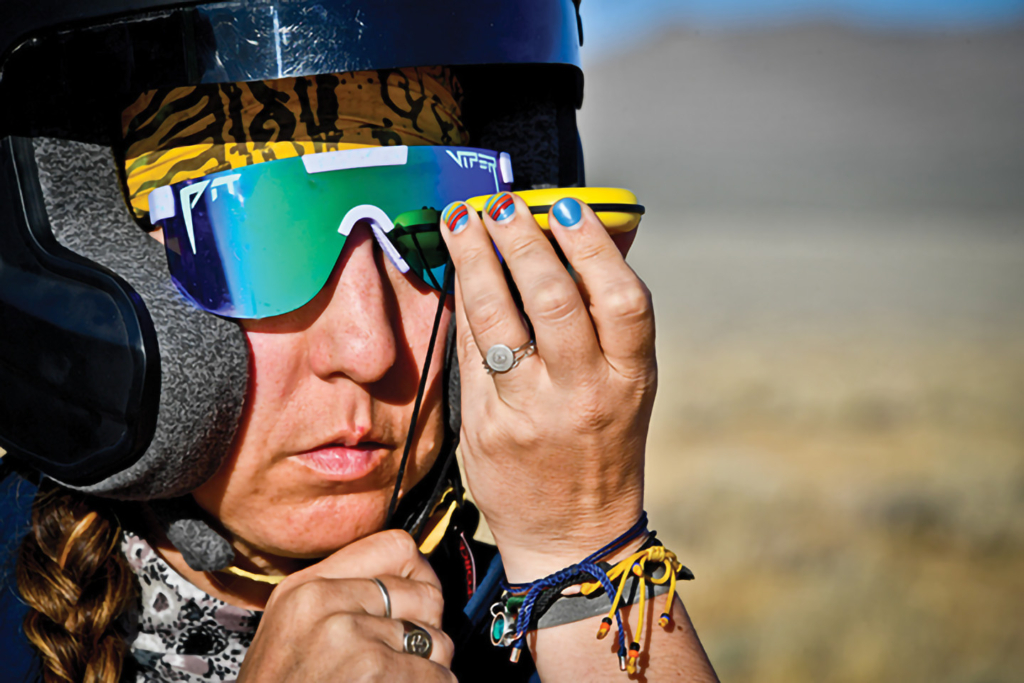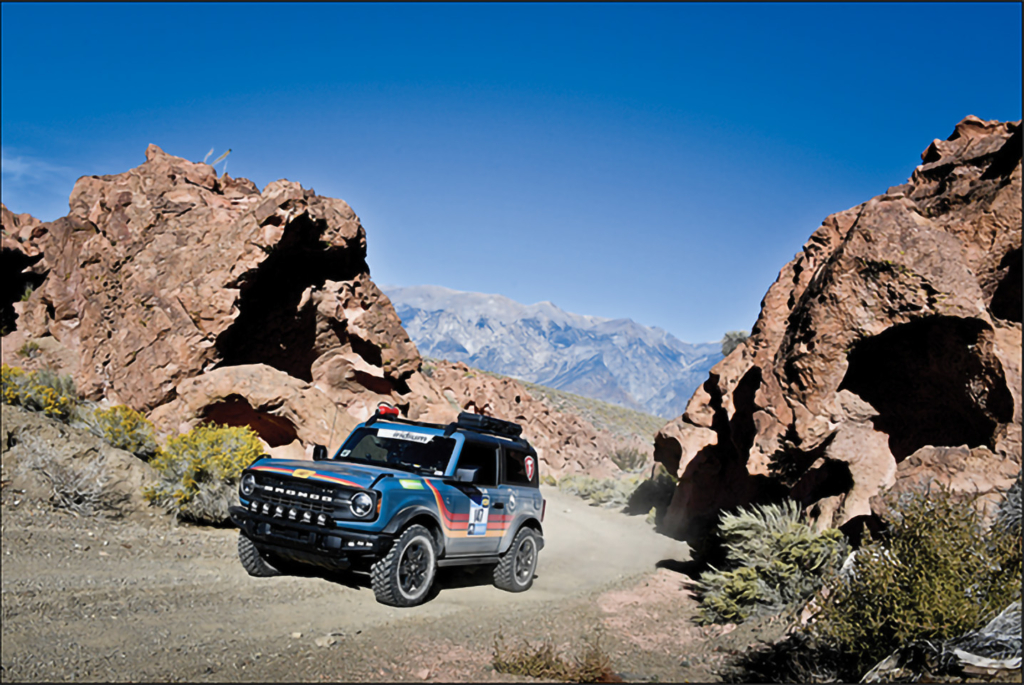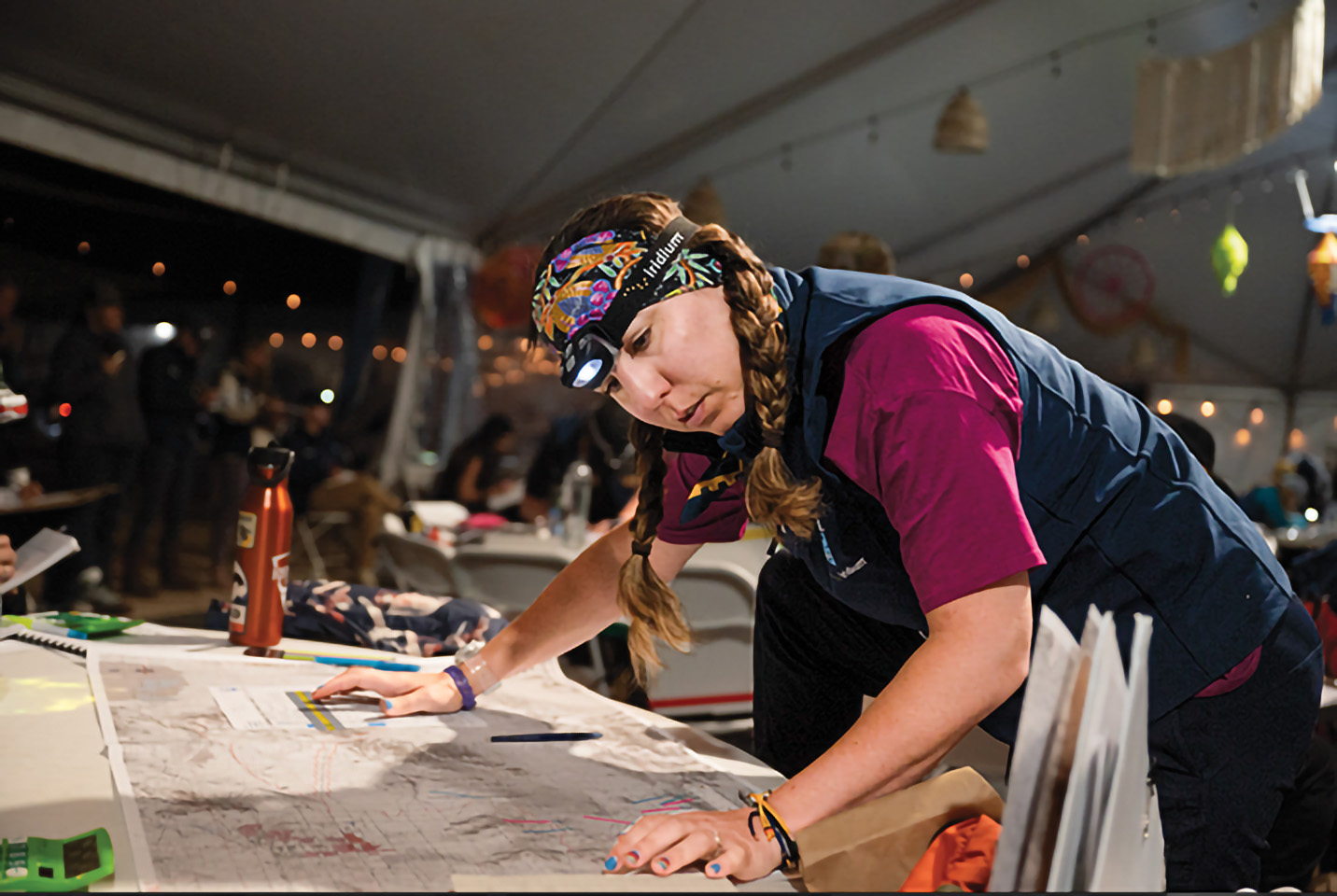Danielle Cheifetz ’05 shows her fortitude during an 8-day competition covering 2,500 kilometers of desert.
It’s early, still dark outside. Through blurred eyes I read 3 a.m. on my faintly glowing wristwatch. I hardly need the timestamp; Mother Nature herself is groaning for five more minutes. The desert air inside my tent is brisk, flirting with 50°F. Normally, I’d find this a bit chilly, but compared with the below-freezing temps we endured a few days ago in the Sierra Nevadas, it feels downright balmy.
I stretch, take a breath, and remind myself — again — that today is a new day. Yesterday is behind me, so that’s where I’ll leave it.
OK, reset.
Dressed, I wearily make my way to the main tent and the coffee inside. I’ve checked my map and compass at least three times now, but give in to the anxiety once more and take a peek. Map, check. Compass, check. Backup compass, check. Backup to the backup compass, check. I can’t stop thinking about the woman who dropped hers down the latrine. It was her only one. The rumor is she retrieved it.
The sun hasn’t yet risen, and already the tent is bustling with activity. Women gather around tables, studiously plotting waypoints. It’s so quiet, you can hear the pencils as they scratch out sleepy calculations of speed-over- distance pacing. A few ladies are crowded around a giant wall-hung map, fingers tracing the day’s approved roads and boundary lines like fine golden tapestry threads.
It is Day 3 — no, Day 4 — of navigating in the longest off-road rally in the entire United States, and my brain has never been this tired. (And that’s saying something, since my day job as a video producer in San Francisco has turned me into a certified logistics wrangler.) Longitude and latitude numbers are bouncing off the sides of my skull and my body has moved past the point of exhaustion, only to circle back around to straight adrenaline again. I am so laser-focused on the task in front of me that it actually startles me. That must be the technology detox kicking in.
Oh God, I have four more days of this.
When I agreed to participate in the 2023 Rebelle Rally, I’ll be honest, I didn’t quite know what I was getting into. I blame Lani, my friend and colleague who asked me to play navigator to her driver during the event. Granted, I liked the idea of participating in a women’s-only endurance rally dedicated to precision and skill, and I expected it to be intense. Hunting hidden checkpoints across 1,500 miles of unforgiving terrain in Nevada and California with no cellphones or GPS devices isn’t exactly a walk in the park. I was, admittedly, intimidated by the days of backcountry camping, and I knew the countless hours spent bouncing over trails in a stock Ford Bronco would likely leave me with a few new bruises.

But planning is what I do, I thought. And so, I planned.
I researched camping gear and recovery tools, joined off-roading groups, and met with veteran Rebelle competitors. Lani and I took driving and navigating classes, signed up for official training events, and explored the terrain where the event would take place. We wrote sponsorship letters and filmed a donation video, endured many nos and celebrated some yeses — including Firestone Tires, an accomplishment in itself since the partnership made us the first-ever Rebelle Rally team to garner the company’s support.
As the training got tougher, so did we. While Lani and I set expectations early in the game to work hard but still have fun (and remain friends), we wanted to be the most prepared rookies on that starting line. I spent an entire year learning how to plot out geofenced coordinates located in remote checkpoints using only analog tools. I ate freeze-dried meals and protein bars, wore moisture-wicking clothing and a Snell helmet while I lounged on the couch. I planned for stress, prepared for discomfort. I made laminated checklists.
Somewhere around Day 2 that all went out the window. (Figuratively speaking, of course, since we also became well versed in Leave No Trace principles.)
In filmmaking, every production essentially starts with a million little hurdles. There’s the Big Idea — the end goal, the finish line — and then there are all the things standing in the way of turning that vision into reality. Budget, permits, conflicting schedules. My job as a producer is to systematically solve each of those problems, one by one. After all, Rome wasn’t built in a day.
Competing in the Rebelle Rally felt strangely, maniacally like trying to build an entire city not just on a shortened timeline but also with only Popsicle sticks for construction materials. And halfway through the endeavor, you realize the ground site is unsteady, the blueprints are actually in Greek, and the entire crew is just as lost as you are.
How do you plan for something that cannot be replicated outside of its very unique pressure cooker environment? The Rebelle Rally is more than its physical and mental exertion. It is these elements combined with the stress of maintaining a vehicle over unrelenting terrain and the shock of waking up to frost after battling triple digits the day before. It is confusing maps and fuzzy math, frustration and failure.
Over, and over, and over again.
If I had known all of this going in — truly understood it — I’m not sure I would have done it. Like most people, I don’t exactly have a great relationship with defeat. It’s not a feeling I like to hang around with, certainly not over a prolonged period of time, nor after I’ve specifically made preparations to avoid it. After running into it several times over eight days, however, I don’t hide my face anymore.
Distance lends perspective, and as I get further from the rally, I can see the lessons taking shape. How to manage frustration — the big, nebulous kind that threatens to bog you down in a dark place. How to drown out negativity with the sound of your own inner cheerleader. How to find — and choose — laughter when screaming into the void is so very tempting. How to breathe. How to bounce back.

About three-quarters through the final day of the competition, our third teammate, Hank (the Bronco), had a run-in with a sand dune and lost a ring gear tooth. With no four-wheel drive and no way to diagnose the problem at the time, Lani and I contemplated heading back to base camp and forfeiting our last big green checkpoint — leaving 19 available points on the table. Could we get through this scorching-hot silty sand without getting stuck? Doubtful, but we didn’t want to give up. It was our last day and by this point, we were absolutely committed to squeezing every last drop from the experience.
As if sensing our determination, Fate intervened. Another team emerged from the dunes and drove over to us. We explained our predicament and they informed us the final checkpoint wasn’t too far away; they even offered to follow us in and help if we got stuck. We did, they did, and we got that last green.
Our journey over the finish line had a bittersweet taste, due to Hank’s condition. We had finished — we did it! But after the high fives and relieved sighs, we still had work to do; mechanics to consult with, rental car arrangements to make. Perhaps it was a fitting conclusion to such a grueling endeavor — one more challenge, just to see if you can take it. I signed up to push myself, after all.
When the dust settled and the scores tallied, we finished in the top 50% of what veteran competitors said was the hardest rally they’d ever experienced. Our team, Dead Reckoning, ranked 26th out of 54 in the 4×4 class (open to four-wheel-drive vehicles with a two-speed transfer case), and sixth out of 26 rookie teams.
While the numbers are nice, it’s the behind-the-scenes bits I’ll be carrying with me. The lessons, the laughter, the landscapes. The risks and payoffs, the frustrations, and yes, even the defeats. There’s a common belief these days that the world is lacking motivation; it’s lost its grit. Well, I found it — in the desert and in myself. (Also in my teeth, my hair, my sleeping bag, my shoes…) Truly, anything else is easy after this. The next time I think a four-day/12-hour shoot is hard, I’ll simply ask myself, “Well, is it harder than that time we broke down in the dunes?”
Danielle Cheifetz ’05 is the founder of Kraken Cove Productions, a San Francisco video production company specializing in tailored support for any style film shoot. A deliberate planner, her philosophy is that efficiency doesn’t matter if you’re not doing the right things with the right people — which is why she’s proud to say that, even when unpredictability strikes on set, her team can always recover. Cheifetz can be reached at dc@krakencoveproductions.com.

